Your front yard is the transition from the rest of your neighborhood to the inside of your home, so its features are important. It's also what your neighbors see when they are out in their own yards, what passersby look at when they drive by and, most important, the first thing you see when you come home.
Large, structural pieces play an integral part in how a front yard is organized and laid out, so give them some thought for an entry that works best for you.
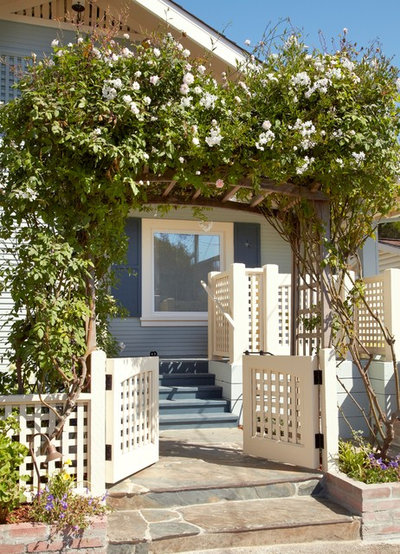
Nancy Van Natta Associates
1. Arbors. There is something very charming and quaint about a front-yard arbor. It not only says, "Welcome"; it seems to holler, "Come on in and visit for a while!" Arbors can accent a cottage, but they can also set off a more contemporary house — it's all in the materials. A rose-topped white lattice looks very traditional, while angular steel with clipped evergreen ivy lends a cool, contemporary vibe. The arbor and plant material offer a one-two punch.
Tip: Resist the urge to overplant your arbor — check the size of the vine you plan to grow on it and plant accordingly. If you are in love with a more diminutive vine, you may need to plant one on either side of the arbor, but only plant one if it's more aggressive, like a 20-footer. Overplanting your arbor may get you faster coverage, but ultimately you may create maintenance issues or plant health problems, or worse, you may weaken the structural integrity of your arbor.
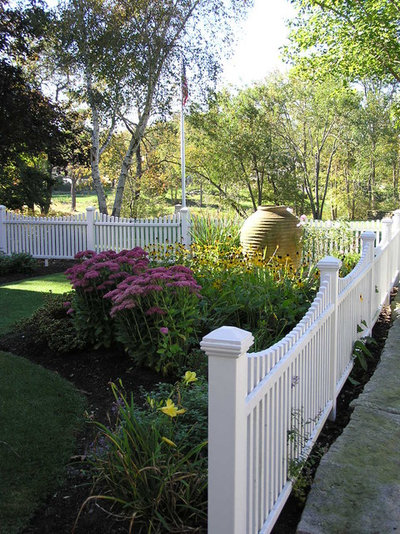
Woodburn & Company Landscape Architecture, LLC
2. Fences. Not every front yard needs a fence, but sometimes it helps to create a separation between the sidewalk and the garden. Front-yard fences should not be the same type of privacy fence as in a backyard; they should be more open and friendlier, setting off your garden rather than sealing it off.
Keep the fencing low, about 3 to 4 feet tall. This way your neighbors can see in without feeling like they can just walk onto your property. Aim for a slightly open and friendly feel, as tall fences say, "Keep out." Choose classic white pickets, rustic split-rail fencing or contemporary horizontal board fencing — just make sure to choose a style that sets off the architecture of your home.
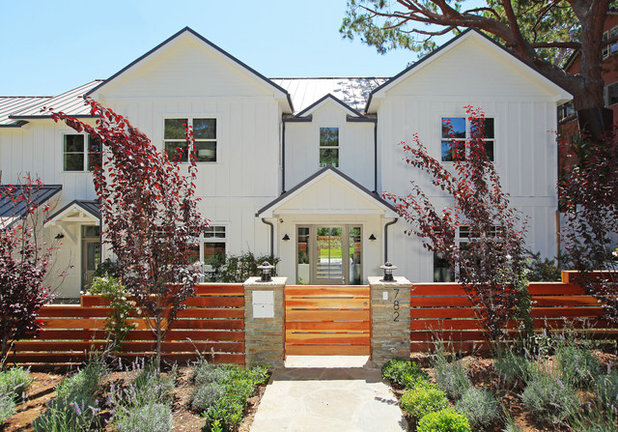
Core Development Group, Inc.
3. Gates. Gates can be built into a fence to signal your visitors where to enter, or they can be added to an arbor for a charming effect. A well-placed and thoughtfully constructed gate sets off the entry while creating a bit of separation from the rest of the world. While not a necessity in most cases, gates provide a thoughtful transition from one space to another.
Tip: Choose your gate hardware wisely — gate latches that are too difficult for visitors to easily open are frustrating, and leave family and friends waiting awkwardly on the sidewalk until you come to rescue them.
More guides to fences and gates
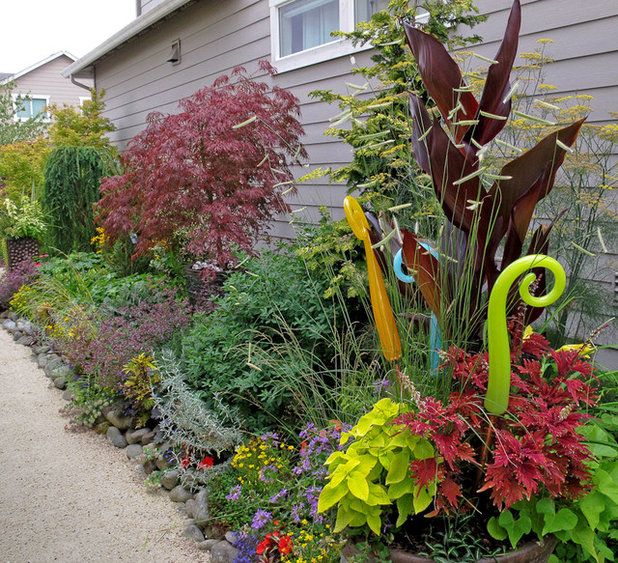
Personal Garden Coach
4. Artwork. Why should artwork be relegated to the backyard? And by artwork, I don't mean small, kitschy pieces you pick up at the craft store — I mean honest-to-goodness artisan-crafted pieces. Tuck in some that are made to withstand the elements, like these stunning glass curlicues. Also look for unique pieces like framed prints that are made for outdoor display, interesting wood pieces that start conversations and forged steel art that can stand alone in the middle of your front lawn.
Make sure that your artwork is suitable for outside and can withstand wind, rain and sun. Don't place glass pieces underneath large trees that could have falling branches, and place expensive artwork closer to the house and secure it properly to avoid theft.
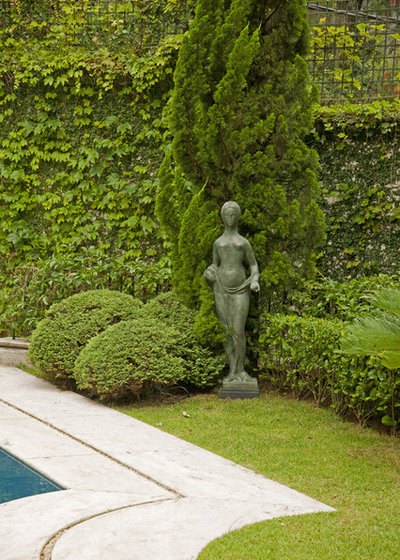
Allan Malouf Studio
5. Statues. Statues go under the heading of artwork as well, of course, but they have a stronger presence than many other art pieces do. Statues lend an air of timelessness and grace to a garden, whether they're custom made or prefabricated and readily available.
Statues should be kept to a minimum in most front yards — one or two well-placed pieces, for example — so as not to overwhelm or crowd the space with too many important pieces. Use evergreen plant material to create a classic backdrop and feel free to add colorful flowers around the base to set it off.
Tip: A statue can be very heavy. Make sure you know where it is going before having it delivered and choose the location wisely, as it will be difficult to move after it is placed.
Get the mystery of a Gothic garden for yourself
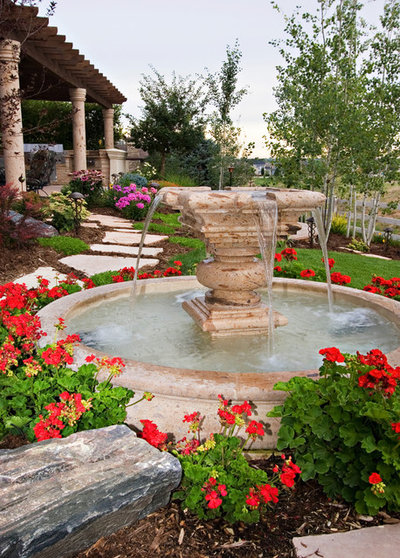
De Santana Handcarved Stone
6. Fountains. Water features create a sensory experience for you and your visitors that is difficult to create in any other way: the sound of trickling or splashing, the movement of falling water and the visual coolness that water provides on a hot day. Fountains can be grand "look at me" features or out-of-the-way accents tucked into a garden, waiting to be discovered.
Be sure your fountain is the correct size and proportion to your home and front yard. I've seen many postage-stamp yards dwarfed by huge three-tiered fountains. If your yard and house are on the smaller side, make sure your fountain is small as well.
35 Fabulous Fountains
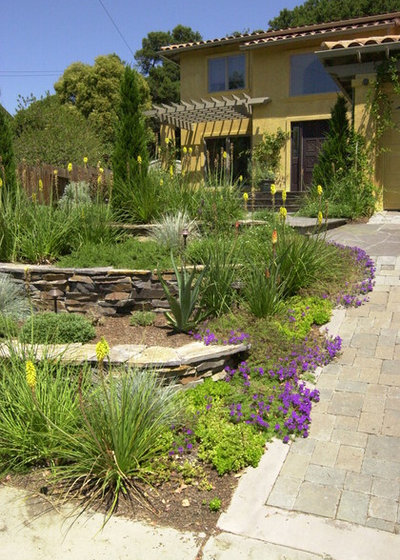
Elemental Design Group
7. Retaining walls. If you have a front yard with a steep slope, you may need to install some retaining walls or terraces to make it more accessible and to keep soil erosion to a minimum. Retaining walls can be a series of low walls, like the ones shown here, to create a gentle step-down effect, and can be made from a variety of eye-catching materials. Rock cut into stackable blocks has a very clean appearance, while larger boulders nestled into the soil look more casual and cottage-y. Steel retaining walls are more contemporary and have a rustic elegance.
If your front yard requires tall retaining walls, contact your local authorities about the city code — in most areas you will need a structural engineer to sign off on any wall that is taller than 3 feet. These types of walls are
not DIY projects, as they need to retain heavy quantities of soil; they should be constructed by experienced professionals.
See how steel retaining walls transformed a steep front yard (includes video)





